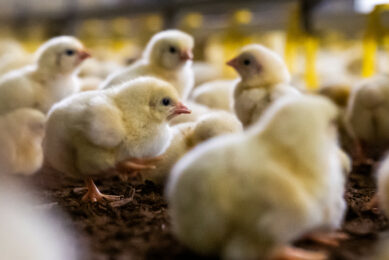Research: Pea hulls in broiler diets
At the Polytechnic University of Madrid in Spain researchers studied the effects of increasing levels of pea hulls in the diet on productive performance, development of the gastrointestinal tract, and nutrient retention of broilers from one to eighteen days of age.
The effects of inclusion of pea hulls (PH) in the diet on growth performance, development of the gastrointestinal tract and nutrient retention were studied in broilers from 1 to 18 d of age.
Trial setup
There were a control diet based on low fibre ingredients (69.3g total dietary fibre (16.1 g crude fibre/kg)) and three additional diets that resulted from the dilution of the basal diet with 25, 50 and 75 g PH/kg (81.2, 93.2, and 105.1 g total dietary fibre/kg diet, respectively).
Each treatment was replicated six times and the experimental unit was a cage with 12 chicks.
Growth performance, development of the gastrointestinal tract and the coefficients of total tract apparent retention (CTTAR) of nutrients were recorded at 6, 12 and 18 d of age.
In addition, jejunal morphology was measured at 12 and 18 d and the coefficients of apparent ileal digestibility (CAID) of nutrients at 18 d of age.
Results
Pea hulls inclusion affected all the parameters studied. The inclusion of 25 and 50 g PH/kg diet improved growth performance as compared to the control diet.
The relative weight (g/kg body weight) of proventriculus, gizzard and caeca increased linearly as the level of PH in the diet increased.
The inclusion of PH affected villus height:crypt depth ratio quadratically with the highest value shown at 25 g PH/kg.
In general, the CTTAR and CAID of nutrients increased linearly and quadratically with increasing levels of PH, showing maximum values with PH level between 25 and 50 g/kg diet.
Conclusion
It was concluded that the size of the digestive organs increases with increasing levels of PH in the diet.
In general, the best performance and nutrient digestibility values were observed with levels of PH within the range of 25 and 50 g/kg.
Therefore, young broilers have a requirement for a minimum amount of dietary fibre. When pea hulls are used as a source of fibre, the level of total dietary fibre required for optimal performance is within the range of 81.2–93.2 g/kg diet (25.6–35.0 g crude fibre/kg diet).
An excess of total dietary fibre (above 93.2 g/kg diet) might reduce nutrient digestibility and growth performance to values similar to those observed with the control diet.
Abstracted from: Animal Feed Science & Technology (Aug 2011)











